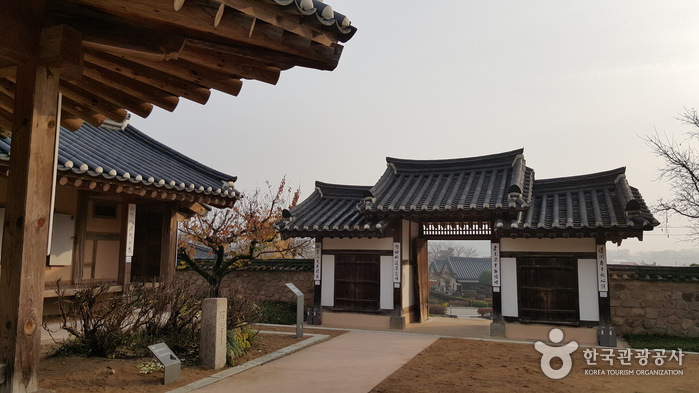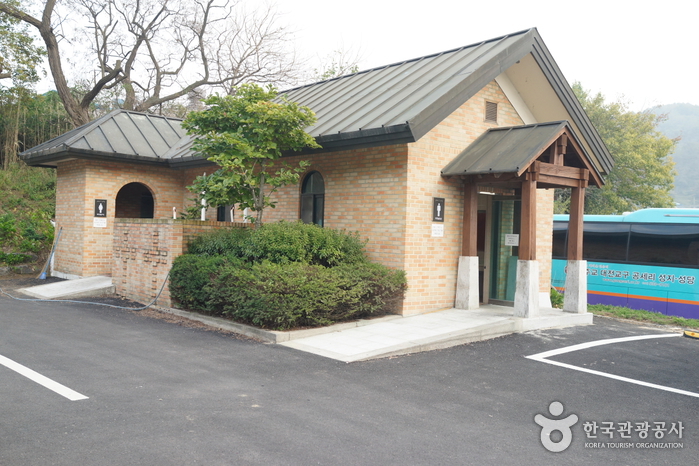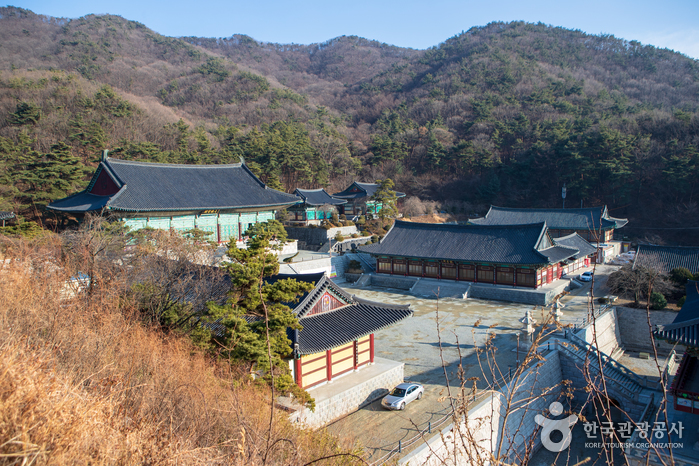House of Chusa (추사고택)
19.4Km 2022-12-28
261, Chusagotaek-ro, Yesan-gun, Chungcheongnam-do
+82-41-339-8248
House of Chusa, Chusa Gotaek in Korean, is the traditional Korean house of the renowned scholar and calligrapher Chusa, also known as Kim Jeong-hui. This old house is known to have been constructed by the great-grandfather of Chusa, Kim Han-Sin.
The Korean-style house compound (266.11 m²) consists of munganchae (a guesthouse), soseuldaemun (a high gate), sarangchae (ㄱ-shaped men's quarters), anchae (ㅁ-shaped women’s quarters) and a shrine where the remains of Chusa are enshrined. Theㄱ-shaped Sarangchae stretches for one kan (traditional measuring unit) to the south and 2 kans to the east and is comprised of two rooms and a daecheongmaru (living area). The Anchae consists of a six-kan daecheongmaru and two one-kan rooms.
Located on the ground is a tomb where Chusa’s great-grandfather (Kim Han-Sin) and his wife (Hwasun Princess) are buried. Nearby, visitors will see a gate that was constructed to commemorate Princess Hwasun’s faithfulness to her husband.
Located approximately 600 meters to the north of the old house is a lacebark pine tree, which was designated as a Natural Monument. The lacebark pine tree, originally from northern China, is among the few of its kind in Korea. It is said that Chusa snuck the pine across the border from China (formerly, the Qing dynasty) into the country when he was 25 years old and planted it at the tomb of his great-grandfather. Originally, the tree had three branches, but two were broken and the third branch was damaged. In 1980, the damaged branch was treated and since then, the tree has been kept under strong protection.
Gongseri Catholic Church (아산 공세리성당)
19.4Km 2024-10-16
10, Gongseriseongdang-gil, Asan-si, Chungcheongnam-do
+82-41-533-8181
Gongseri Catholic Church was founded in 1894 as the main parish of the Daejeon diocese in Gongse-ri, Inju-myeon that connects Asanman Bay to Sapgyocheon Stream. Early missionaries originally used a common house for church meetings in the early years until in 1897 when a rectory was built, followed by the establishment of the main church in 1922. This was the first Catholic church in Chungcheongnam-do and the religion spread across Anseong, Onyang, and Dunpo to establish regional churches respectively. The grounds have three graves of prosecuted martyrs, a parish and rectory, retreat house, and meeting room. The premises is surrounded by beautiful views of a lush forest.
House and Tomb of Kim Jeong-hui (추사김정희선생고택·묘)
19.5Km 2024-02-21
261, Chusagotaek-ro, Sinam-myeon, Yesan-gun, Chungcheongnam-do
This house and tomb are where Kim Jeong-hui (pen name: Chusa, 1786-1856), a Joseon-era scholar and artist, lived and was laid to rest. Chusa Memorial Hall and Chusa Experience Center are found next to the house. After studying in Qing China, Kim Jeong-hui served in multiple government posts. He is best known for his unique calligraphical style, which bears his courtesy name (Chusa), and many works of art that survive to this day. The Experience Center offers traditional art experiences inspired by Kim Jeong-hui’s works.
Gakwonsa Temple (각원사)
19.8Km 2024-03-15
245 Gagwonsa-gil, Dongnam-gu, Cheonan-si, Chungcheongnam-do
+82-41-561-3545
Gakwonsa Temple, nestled midway up Taejosan Mountain in Cheonan, stands as a beacon of hope for the peaceful reunification of Korea. The temple's most renowned feature is the immense bronze statue of the seated Amitabha Buddha, which measures 15 meters in x_height, 30 meters in circumference, and weighs 60 tons. Additionally, Gakwonsa Temple is distinguished by its Daeungjeon Hall, the largest Dharma Hall in Korea. The temple's Gaesan Memorial Hall houses a collection of artifacts associated with the temple.
Geumisanseong Fortress (금이성)
19.8Km 2025-05-20
Songseong-ri, Sejong-si
+82-44-300-3444
Geumiseong is a mountain fortress built on the summit of Geumseongsan Mountain, which rises 430 meters above sea level. It overlooks Jeonui and Cheonan to the north and Geumgang River to the south. The architecture style of Geumiseong Fortress is a combination of the
styles of the Baekje dynasty and the early Unified Silla. Based on the relics found inside the fortress, it is thought to have been built in the Goryeo period. The robustness of the fortress takes advantage of the rugged topography, so much so that it had been known as ironclad bastion among common people.
The eastern side of the fortress has considerably collapsed, but the southern part is in a relatively good condition. The western and northern walls are also in bad conditions.
Some earthenware pieces were found where there once stood a watchtower. Also, some pieces of roof tiles were found where there was a fortress building in the central part of the fortress on mountain summit. The earthenware pieces are hard porcelain and soft glass wares like bowls and pots. The tile pieces mostly feature fishbone patterns in dark gray color.




 English
English
 한국어
한국어 日本語
日本語 中文(简体)
中文(简体) Deutsch
Deutsch Français
Français Español
Español Русский
Русский